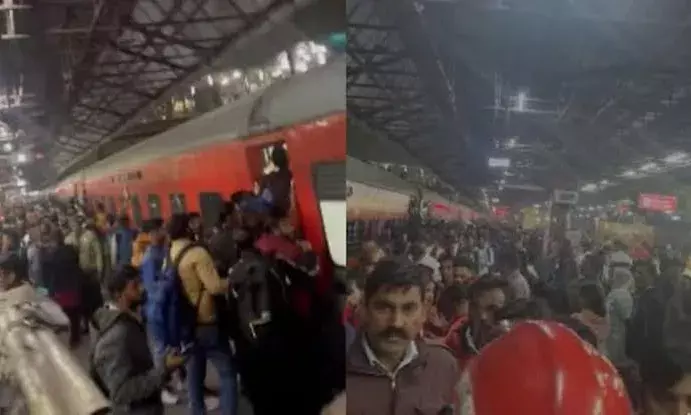New Delhi Railway Station Stampede: A Tragedy of Neglect and the Urgent Need for Accountability

The recent stampede at New Delhi Railway Station, which claimed at 18 lives and left dozens injured, is not just a tragic accident—it is a stark reminder of systemic failures that have become all too common in India. From overcrowded railway platforms to collapsing bridges, from mismanaged pandemic responses to fatal police lathi charges, the Indian public has endured a relentless series of crises. Each incident follows a familiar pattern: initial outrage, hollow promises of reform, and eventual amnesia until the next disaster strikes. The New Delhi stampede is yet another example of how negligence and apathy have normalized death in public spaces. It is time to demand accountability and systemic change.
The immediate cause of the stampede—a rumor about an incoming train—may seem trivial, but it exposes the fragility of India’s public infrastructure. New Delhi Railway Station, designed decades ago to handle a fraction of its current footfall, is a ticking time bomb. Narrow staircases, inadequate signage, and a lack of emergency exits create chaos during peak hours. On the day of the stampede, the absence of crowd control measures and broken CCTV cameras exacerbated the crisis.
Railway officials were quick to blame “public panic,” deflecting attention from their own failures. Crowd management is not an insurmountable challenge; it requires planning, investment, and accountability. The 2013 Allahabad (now Prayagraj) Kumbh Mela, which safely hosted millions of pilgrims, demonstrated that India is capable of managing large crowds when there is political will. Yet, at New Delhi Railway Station, a ₹1,000 crore modernization plan announced in 2019 remains stalled, buried under bureaucratic inertia and misplaced priorities.
The New Delhi stampede is not an isolated incident. It is part of a recurring pattern of negligence and apathy. The 2017 Elphinstone Road station stampede in Mumbai, which killed 23 people, was blamed on rain and overcrowding. An inquiry panel recommended infrastructure upgrades, but these recommendations were ignored. Similarly, the 2016 footbridge collapse at the same New Delhi station injured 27 people, yet no significant changes were made to prevent future accidents.
Political leaders across party lines have failed to prioritize public safety. The Railways Ministry, often treated as a bargaining chip in coalition governments, suffers from chronic underinvestment. While funds are diverted to high-profile projects like Vande Bharat trains, basic safety measures at overcrowded stations are neglected. This pattern of neglect is not limited to railways. From collapsing flyovers to poorly managed public events, India’s infrastructure and governance systems are riddled with flaws that cost lives.
Stories of affected families highlight the human cost of systemic failures. For the marginalized—daily wage workers, farmers, and the urban poor—death in public spaces has become an ever-present risk. Whether it is standing in line for hours during demonetization, protesting for fair crop prices, or navigating overcrowded railway stations, the most vulnerable bear the brunt of institutional neglect.
Accountability must begin at the top. Station managers, responsible for daily operations, ignored repeated warnings about bottlenecks. Senior railway bureaucrats delayed approvals for upgrades, prioritizing optics over safety. Political leaders, including the Railways Minister, must answer for systemic underfunding and misplaced priorities. The Delhi government, tasked with urban governance, failed to collaborate on crowd control measures, reflecting a broader culture of jurisdictional buck-passing.
Legal frameworks exist to hold officials accountable. The Disaster Management Act (2005) mandates preventive measures, while criminal negligence charges apply under Section 304A of the Indian Penal Code. Yet, prosecutions are rare. After the 2011 Sabarimala stampede, which claimed 106 lives, only low-level officials faced reprimands. Without consequences for decision-makers, complacency thrives, and tragedies repeat.
Immediate measures are clear: deploy AI-driven crowd analytics, install emergency exits, and increase staff during peak hours. Long-term solutions require political courage: fast-tracking station modernization, decentralizing traffic to underutilized stations, and integrating metro and bus routes to reduce railway footfall.
Transparency is key. Independent audits of railway spending, citizen oversight committees, and mandatory safety drills can rebuild trust. Japan’s railway system, where punctuality and safety are sacrosanct, offers a model: regular disaster simulations and public awareness campaigns ensure that safety is never compromised.
The New Delhi stampede is a wake-up call. It is a reminder that accountability cannot end with suspending a station master or announcing compensation. It must catalyze systemic reform. Public safety must eclipse political expediency. As citizens, we must demand more than platitudes—we deserve infrastructure and governance that reflect our dignity.
The time for action is now. Let this tragedy be the last. Let us reject the normalization of death in public spaces and demand a future where safety, accountability, and humanity are non-negotiable.
Babasaheb B.R. Ambedkar once warned, “In India, democracy is only a top-dressing on an undemocratic soil.” To till this soil anew, we must plant seeds of accountability—or risk reaping more death. The choice is ours. Let us choose wisely.

